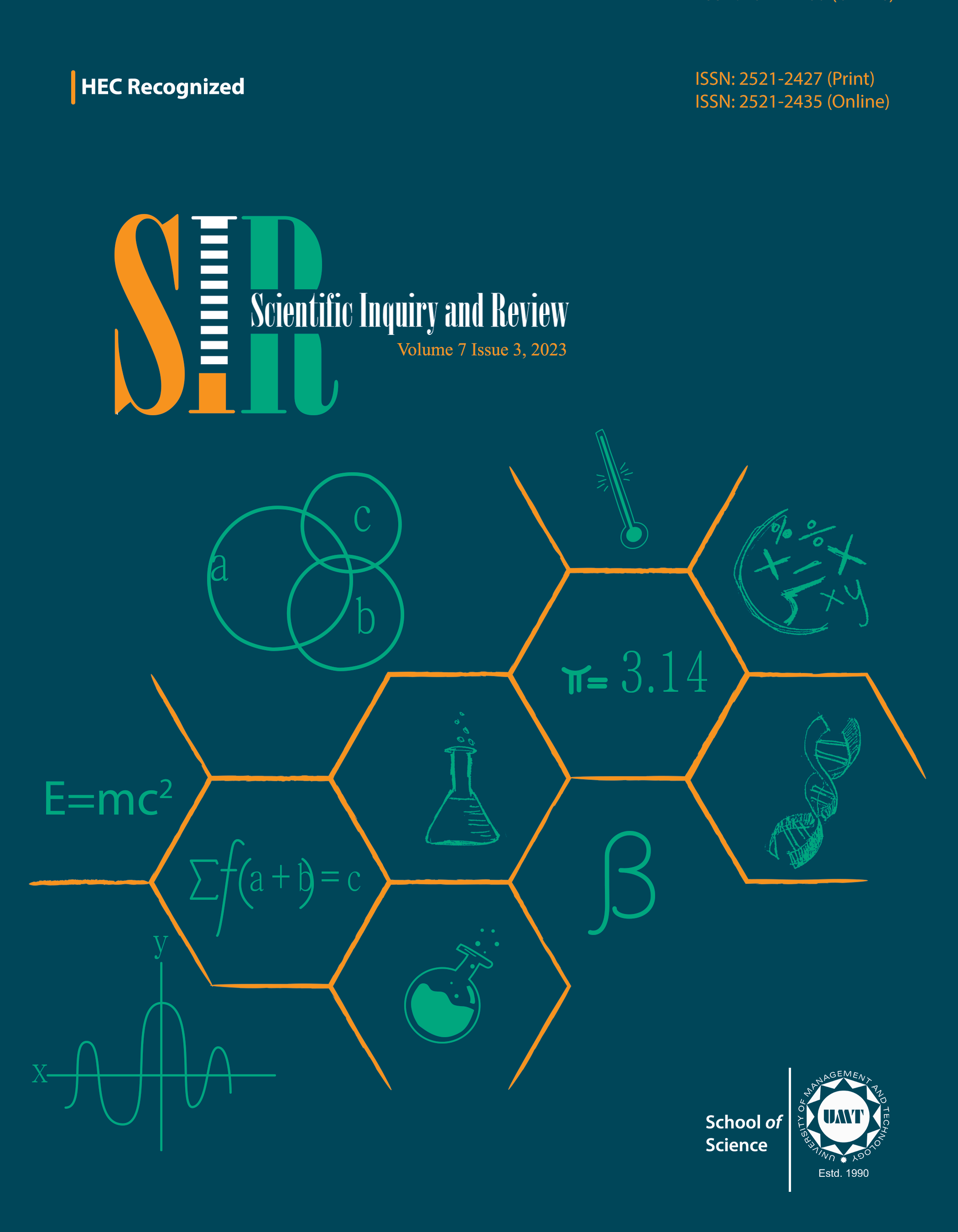Rising Arsenic Level in Drinking Water: A Study of Schools and Local Areas of Multan, Pakistan
Abstract
 Abstract Views: 0
Abstract Views: 0
Water is the basic need for the survival of all living organisms; however, its contamination has caused disastrous effects on human health. Almost 80% of the total population in Pakistan is forced to use unsafe drinking water due to the scarcity of clean water sources. To assess, the risk involved and to monitor the amount of Arsenic and bacterial growth in drinking water, water samples were collected from different government schools and underdeveloped areas of Multan, Pakistan. Moreover, water samples were collected by randomly visiting areas and were sent for laboratory analysis to determine and detect the arsenic amount along with other parameters including aesthetic, physical, chemical, and bacteriological growth. The results indicated that all the data collected from Govt. schools and developed locality were having a large amount of arsenic in drinking water. A huge amount of Coliform growth was found in the Peer colony water, which indicated a highly unhealthy intensity of pollutant water for the population residing in this area. Therefore, urgent and regular monitoring of drinking water in Multan was required to prevent such contamination.
Downloads
References
Haydar S, Arshad M, Aziz JA. Evaluation of drinking water quality in urban areas of Pakistan: A case study of southern Lahore. Pak J Eng Appl Sci. 2009;5:16–23.
Daud MK, Nafees M, Ali S, et al. Drinking water quality status and contamination in Pakistan. BioMed. Res Int. 2017;2017:e7908183. https://doi.org/10.1155/2017/7908183
Nazeer S, Hashmi MZ, Malik RN. Heavy metals distribution, risk assessment and water quality characterization by water quality index of the River Soan, Pakistan. Ecol Indicat. 2014;43:262–270. https://doi.org/10.1016/J.ECOLIND.2014.03.010
Nabeela F, Azizullah A, Bibi R, et al. Microbial contamination of drinking water in Pakistan--a review. Environ Sci Pollut Res Int. 2014;21(24):13929–13942. https://doi.org/10.1007/s11356-014-3348-z
Meeting the MDG drinking water and sanitation target: A mid-term assessment of progress. World Health Organization; 2004. https://apps.who.int/iris/bitstream/handle/10665/43021/9241562781.pdf?sequence=1&isAllowed=y
Pakistan: Unsafe water kills 250,000 children annually. Child Rights International Network Web site. https://archive.crin.org/en/library/news-archive/pakistan-unsafe-water-kills-250000-children-annually.html. Updated April 19, 2011. Accessed December 31, 2022.
Arain MB, Ullah I, Niaz A, et al. Evaluation of water quality parameters in drinking water of district Bannu, Pakistan: Multivariate study. Sustain Water Qual Ecol. 2014;3-4:114–123. https://doi.org/10.1016/j.swaqe.2014.12.005
Murtaza B, Nazeer H, Natasha, et al. Hydrogeochemical investigation of arsenic in drinking water of schools and age dependent risk assessment in Vehari District, Punjab Pakistan: A multivariate analysis. Environ Sci Pollut Res. 2020;27(24):30530–30541. https://doi.org/10.1007/s11356-020-09334-7
Bhutta MN, Chaudhry MR, Chaudhry AH, Yasmin N. Groundwater quality and availability in Pakistan. Seminar on Strategies to Address the Present and Future Water Quality Issues; 6–7, 2002; Islamabad, Pakistan. https://inis.iaea.org/search/searchsinglerecord.aspx?recordsFor=SingleRecord&RN=36058280
Nawaz S, Ali Y. Factors affecting the performance of water treatment plants in Pakistan. Water Conserv Sci Eng. 2018;3(3):191–203. https://doi.org/10.1007/s41101-018-0051-9
Khanoranga, Khalid S. An assessment of groundwater quality for irrigation and drinking purposes around brick kilns in three districts of Balochistan province, Pakistan, through water quality index and multivariate statistical approaches. J Geochem Explor. 2019;197:14–26. https://doi.org/10.1016/j.gexplo.2018.11.007
Aziz JA. Management of source and drinking-water quality in Pakistan. East Mediterr Health J. 2005;11(5-6):1087–1098.
Gul M, Mashhadi AF, Iqbal Z, Qureshi TI. Monitoring of arsenic in drinking water of high schools and assessment of carcinogenic health risk in Multan, Pakistan. Human Ecol Risk Assess. 2020;26(8):2129–2141. https://doi.org/10.1080/10807039.2019.1653167
Ali W, Aslam MW, Feng C, et al. Unraveling prevalence and public health risks of arsenic, uranium and co-occurring trace metals in groundwater along riverine ecosystem in Sindh and Punjab, Pakistan. Environ Geochem Health. 2019;14:2223–2238. https://doi.org/10.1007/s10653-019-00278-7
Asfandyar S, Shihua Q, Zaheer M. Arsenic contamination, subsequent water toxicity, and associated public health risks in the lower Indus plain, Sindh province, Pakistan. Environ Sci Pollut Res Int. 2019;26(30):30642–30662. https://doi.org/10.1007/s11356-018-2320-8
Copyright (c) 2023 Muhammad Zohaib Zulfiqar, Faiza Rao, Anam Rao, Syeda Fizza Raza Zaidi

This work is licensed under a Creative Commons Attribution 4.0 International License.






